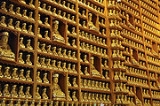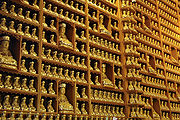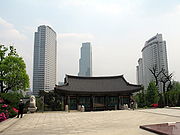
Bongeunsa
Encyclopedia
Bongeunsa is a Buddhist
temple in Gangnam-gu
, Seoul
, South Korea
. It was founded in 794 during the reign of King Wonseong
by the monk Yeon-hoe, then the highest ranking monk of Silla
, and originally named Kyongseoungsa. It is located on the slope of Sudo Mountain in Samseong-dong, across the street from the COEX Mall
.
During the Joseon Dynasty
, Buddhism in Korea
was severely repressed. However, Bongeunsa was reconstructed in 1498 under the patronage of a Joseon Queen. With the support of Queen Munjeong
, who revived Buddhism in Korea
for a short time in the mid-16th century, it became the main temple of the Korea
n Seon (Zen) sect of Buddhism from 1551 through 1936. Monk Bo-wu was appointed head of the temple in 1548 by Queen Munjeong but was killed soon afterwards as the anti-Buddhist factions regained dominance in Korea towards the end of Queen Munjeong's rule. From 1552-1564 it was the center of the Buddhist National Exam.
A fire in 1939 destroyed most of the buildings, and other parts of the temple were destroyed during the Korean War
. Fortunately, one of the very few halls which escaped destruction during the Korean War continues to hold the woodblock
carvings of the Flower Garland Sutra, 봉completed in 1855 by monk Young-ki The temple has undergone many repairs and renovations, and is now once again a large, thriving complex. The reconstruction efforts are being waged even today.
The temple is also a notable tourist destination, offering a "Temple Stay Program" in which visitors can lead the life of a monk for a few hours.

 Bongeunsa was made one of Korea's 14 major temples in 1902. During the Japanese occupation the temple became the headquarters of 80 smaller Buddhist temples around Seoul. In 1922 and 1929, the head monk Cheong-ho saved over 700 people from drowning in the Han river
Bongeunsa was made one of Korea's 14 major temples in 1902. During the Japanese occupation the temple became the headquarters of 80 smaller Buddhist temples around Seoul. In 1922 and 1929, the head monk Cheong-ho saved over 700 people from drowning in the Han river
, an act that inspired a monument of recognition. After colonial rule Bongeunsa became subordinate to the Jogye order, the largest Buddhist sect in Korea.
Buddhism
Buddhism is a religion and philosophy encompassing a variety of traditions, beliefs and practices, largely based on teachings attributed to Siddhartha Gautama, commonly known as the Buddha . The Buddha lived and taught in the northeastern Indian subcontinent some time between the 6th and 4th...
temple in Gangnam-gu
Gangnam-gu
Gangnam-gu is one of the 25 gu which make up the city of Seoul, South Korea. It is one of the most affluent areas of Seoul and is located in the southeast of the city...
, Seoul
Seoul
Seoul , officially the Seoul Special City, is the capital and largest metropolis of South Korea. A megacity with a population of over 10 million, it is the largest city proper in the OECD developed world...
, South Korea
South Korea
The Republic of Korea , , is a sovereign state in East Asia, located on the southern portion of the Korean Peninsula. It is neighbored by the People's Republic of China to the west, Japan to the east, North Korea to the north, and the East China Sea and Republic of China to the south...
. It was founded in 794 during the reign of King Wonseong
Wonseong of Silla
Wonseong of Silla was the 38th to rule the Korean kingdom of Silla. He was a twelfth-generation descendant of King Naemul. His father was Kim Hyo-yang, and his mother was Lady Gye-o, the daughter of Pak Chang-do...
by the monk Yeon-hoe, then the highest ranking monk of Silla
Silla
Silla was one of the Three Kingdoms of Korea, and one of the longest sustained dynasties in...
, and originally named Kyongseoungsa. It is located on the slope of Sudo Mountain in Samseong-dong, across the street from the COEX Mall
COEX Mall
COEX Mall is an underground shopping mall located in Gangnam-gu Seoul, South Korea. It is Asia's largest underground shopping mall with an area of about 85,000 square metres...
.
During the Joseon Dynasty
Joseon Dynasty
Joseon , was a Korean state founded by Taejo Yi Seong-gye that lasted for approximately five centuries. It was founded in the aftermath of the overthrow of the Goryeo at what is today the city of Kaesong. Early on, Korea was retitled and the capital was relocated to modern-day Seoul...
, Buddhism in Korea
Korean Buddhism
Korean Buddhism is distinguished from other forms of Buddhism by its attempt to resolve what it sees as inconsistencies in Mahayana Buddhism. Early Korean monks believed that the traditions they received from foreign countries were internally inconsistent. To address this, they developed a new...
was severely repressed. However, Bongeunsa was reconstructed in 1498 under the patronage of a Joseon Queen. With the support of Queen Munjeong
Queen Munjeong
Queen Munjeong was the wife of King Jungjong of Joseon.She was of the Papyeong Yun clan. She was regent for her son King Myeongjong when he was still too young to rule by himself until 1565. Known as a good administrator, she continued to rule even after he reached the age of majority...
, who revived Buddhism in Korea
Korea
Korea ) is an East Asian geographic region that is currently divided into two separate sovereign states — North Korea and South Korea. Located on the Korean Peninsula, Korea is bordered by the People's Republic of China to the northwest, Russia to the northeast, and is separated from Japan to the...
for a short time in the mid-16th century, it became the main temple of the Korea
Korea
Korea ) is an East Asian geographic region that is currently divided into two separate sovereign states — North Korea and South Korea. Located on the Korean Peninsula, Korea is bordered by the People's Republic of China to the northwest, Russia to the northeast, and is separated from Japan to the...
n Seon (Zen) sect of Buddhism from 1551 through 1936. Monk Bo-wu was appointed head of the temple in 1548 by Queen Munjeong but was killed soon afterwards as the anti-Buddhist factions regained dominance in Korea towards the end of Queen Munjeong's rule. From 1552-1564 it was the center of the Buddhist National Exam.
A fire in 1939 destroyed most of the buildings, and other parts of the temple were destroyed during the Korean War
Korean War
The Korean War was a conventional war between South Korea, supported by the United Nations, and North Korea, supported by the People's Republic of China , with military material aid from the Soviet Union...
. Fortunately, one of the very few halls which escaped destruction during the Korean War continues to hold the woodblock
Woodcut
Woodcut—occasionally known as xylography—is a relief printing artistic technique in printmaking in which an image is carved into the surface of a block of wood, with the printing parts remaining level with the surface while the non-printing parts are removed, typically with gouges...
carvings of the Flower Garland Sutra, 봉completed in 1855 by monk Young-ki The temple has undergone many repairs and renovations, and is now once again a large, thriving complex. The reconstruction efforts are being waged even today.
The temple is also a notable tourist destination, offering a "Temple Stay Program" in which visitors can lead the life of a monk for a few hours.
Bongeunsa under Japanese rule


Han River (Korea)
The Han River is a major river in South Korea and the fourth longest river on the Korean peninsula after the Amnok, Duman, and Nakdong rivers. It is formed by the confluence of the Namhan River , which originates in Mount Daedeok, and the Bukhan River , which originates on the slopes of Mount...
, an act that inspired a monument of recognition. After colonial rule Bongeunsa became subordinate to the Jogye order, the largest Buddhist sect in Korea.
See also
- List of Buddhist temples in Seoul
- Korean BuddhismKorean BuddhismKorean Buddhism is distinguished from other forms of Buddhism by its attempt to resolve what it sees as inconsistencies in Mahayana Buddhism. Early Korean monks believed that the traditions they received from foreign countries were internally inconsistent. To address this, they developed a new...
- Korean architectureKorean architectureKorean architecture refers to the built environment of Korea from c. 30,000 BC to the present.-Introduction:From a technical point of view, buildings are structured vertically and horizontally...
- Korean Buddhist templesKorean Buddhist templesBuddhist temples are an important part of the Korean landscape. This article gives a brief overview of Korean Buddhism, then describes some of the more important temples in Korea. Most Korean temples have names ending in -sa , which means "temple", or ancient temple.-Introduction to Korean...
- List of Korea-related topics
- Japanese occupation of Korea
External links
- Bongeun (Official site)
- Asian Historical Architecture: Bongeunsa Temple

